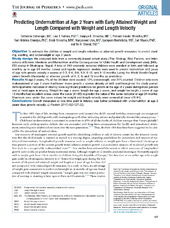Predicting undernutrition at age 2 years with early attained weight and length compared with weight and length velocity
Schwinger, Catherine; Fadnes, Lars Thore; Shrestha, Sanjaya Kumar; Shrestha, Prakash Sunder; Chandyo, Ram Krishna; Shrestha, Binob; Ulak, Manjeswori; Bodhidatta, Ladaporn; Mason, Carl J.; Strand, Tor A.
Peer reviewed, Journal article
Published version

Åpne
Permanent lenke
https://hdl.handle.net/1956/17225Utgivelsesdato
2017Metadata
Vis full innførselSamlinger
Originalversjon
https://doi.org/10.1016/j.jpeds.2016.11.013Sammendrag
Objective: To estimate the abilities of weight and length velocities vs attained growth measures to predict stunting, wasting, and underweight at age 2 years. Study design: We analyzed data from a community-based cohort study (The Etiology, Risk Factors, and Interactions of Enteric Infections and Malnutrition and the Consequences for Child Health and Development study [MAL-ED] study) in Bhaktapur, Nepal. A total of 240 randomly selected children were enrolled at birth and followed up monthly up to age 24 months. Linear and logistic regression models were used to predict malnutrition at 2 years of age with growth velocity z scores at 0-3, 0-6, 3-6, 6-9, 6-12, and 9-12 months (using the World Health Organization Growth Standards) or attained growth at 0, 3, 6, and 12 months as predictors. Results: At age 2 years, 4% of the children were wasted, 13% underweight, and 21% stunted. Children who were malnourished at age 2 years had lower mean growth z scores already at birth and throughout the study period. Anthropometric indicators in infancy were significant predictors for growth at the age of 2 years during most periods and at most ages in infancy. Weight-for-age z score, length-for-age z score, and weight-for-length z score at age 12 months had excellent areas under the curve (91-95) to predict the value of the same indicator at age 24 months. Maximum area under the curve values for weight and length velocity were somewhat lower (70-84). Conclusions: Growth measured at one time point in infancy was better correlated with undernutrition at age 2 years than growth velocity.